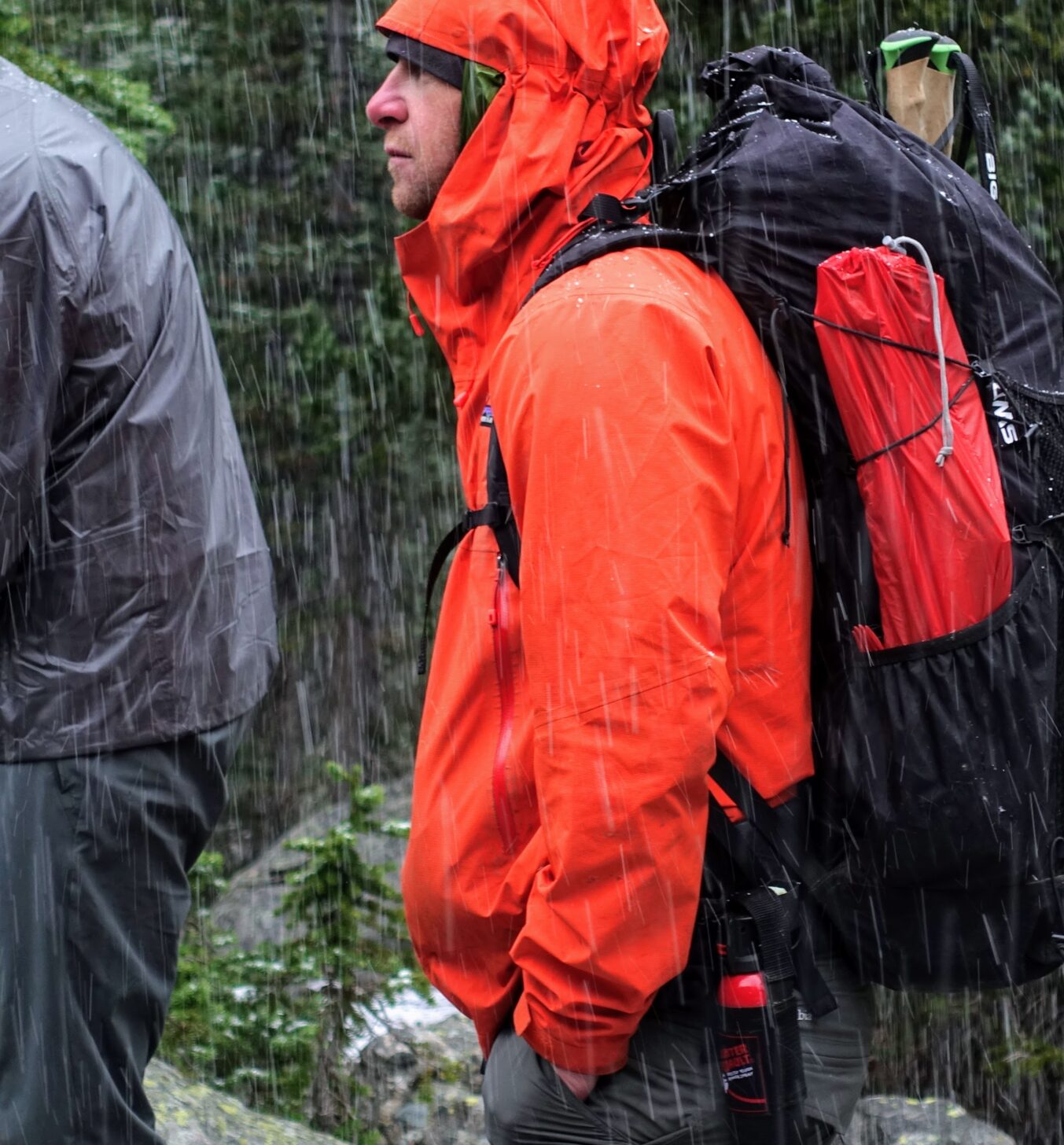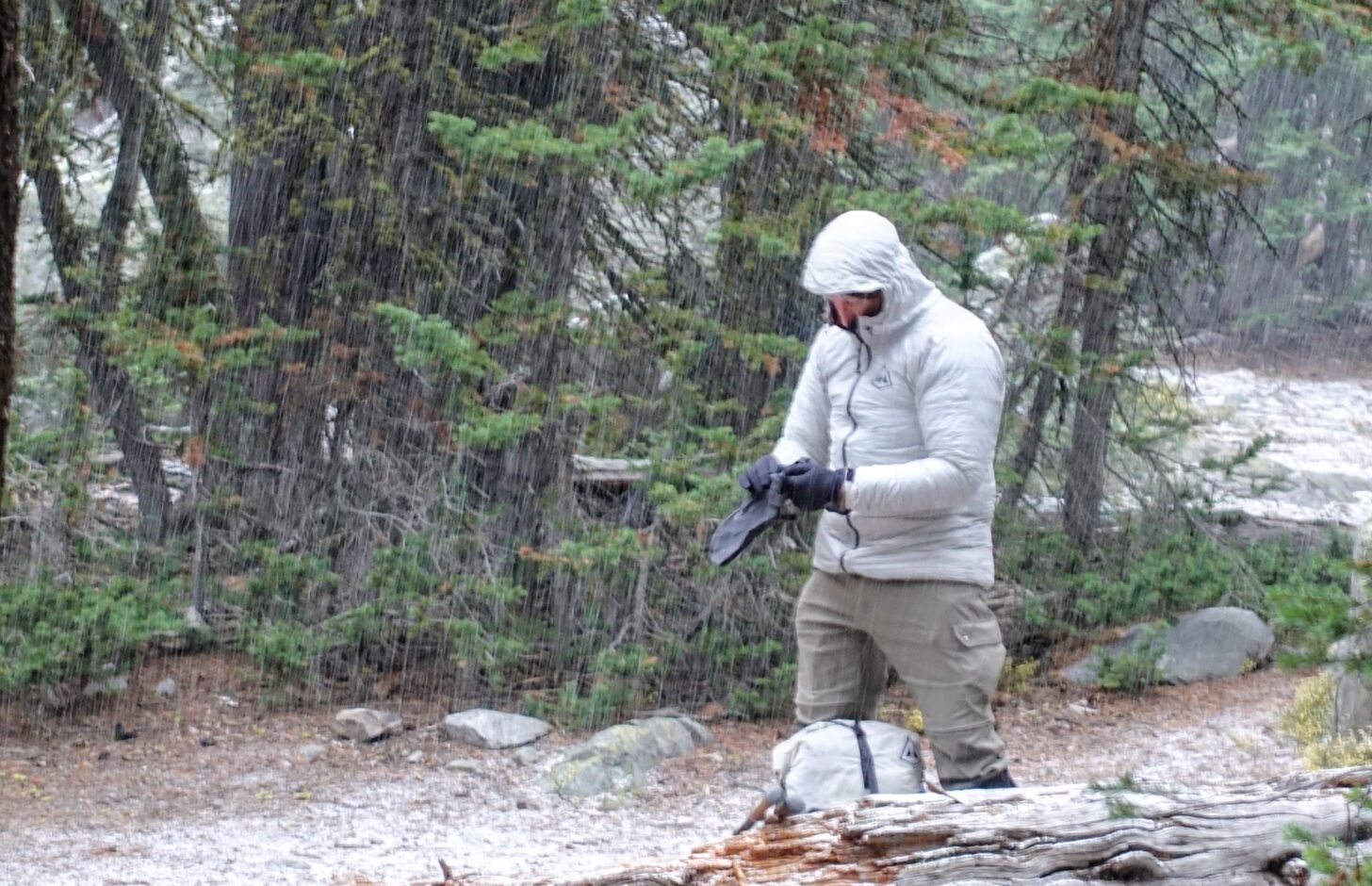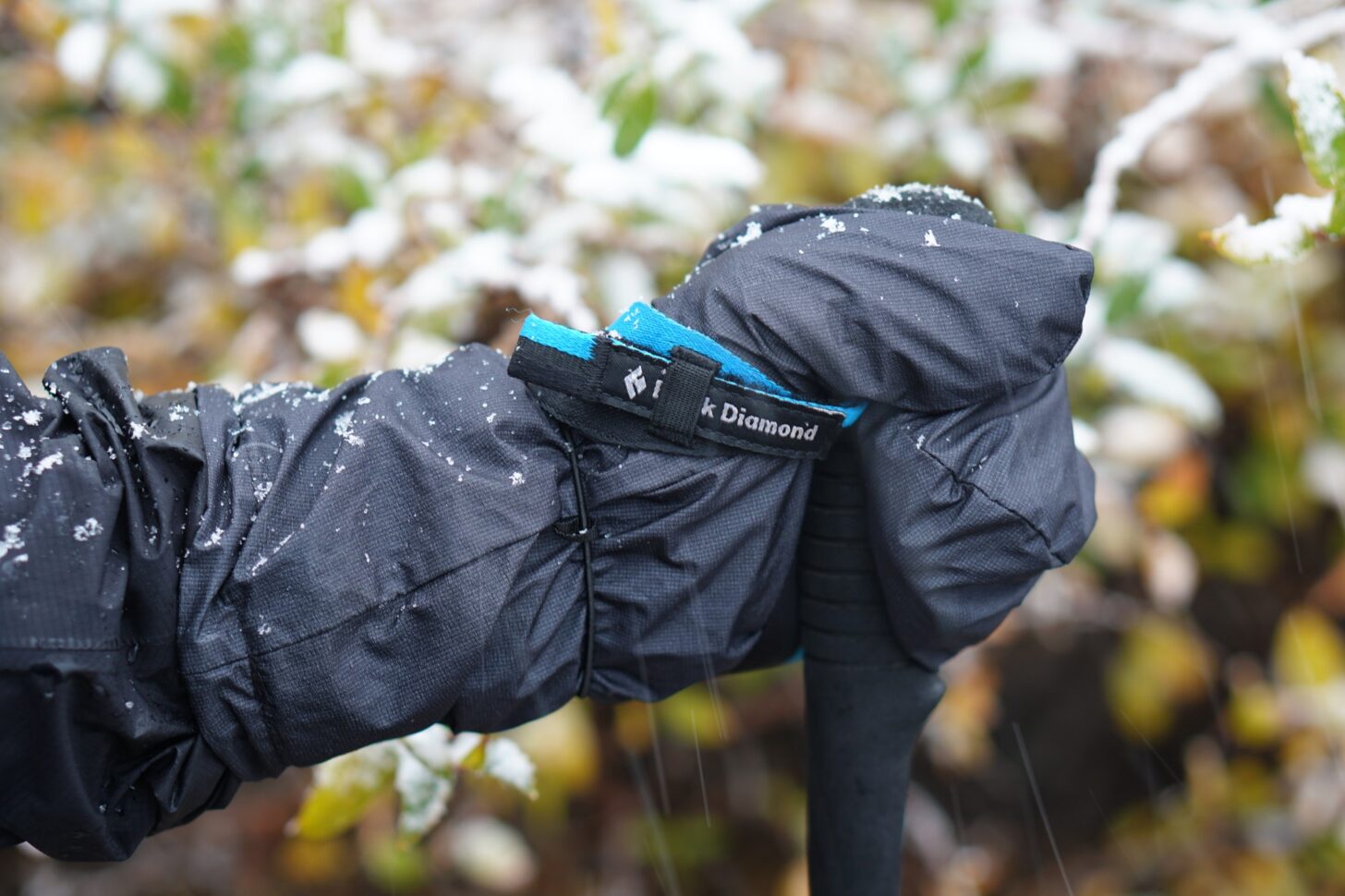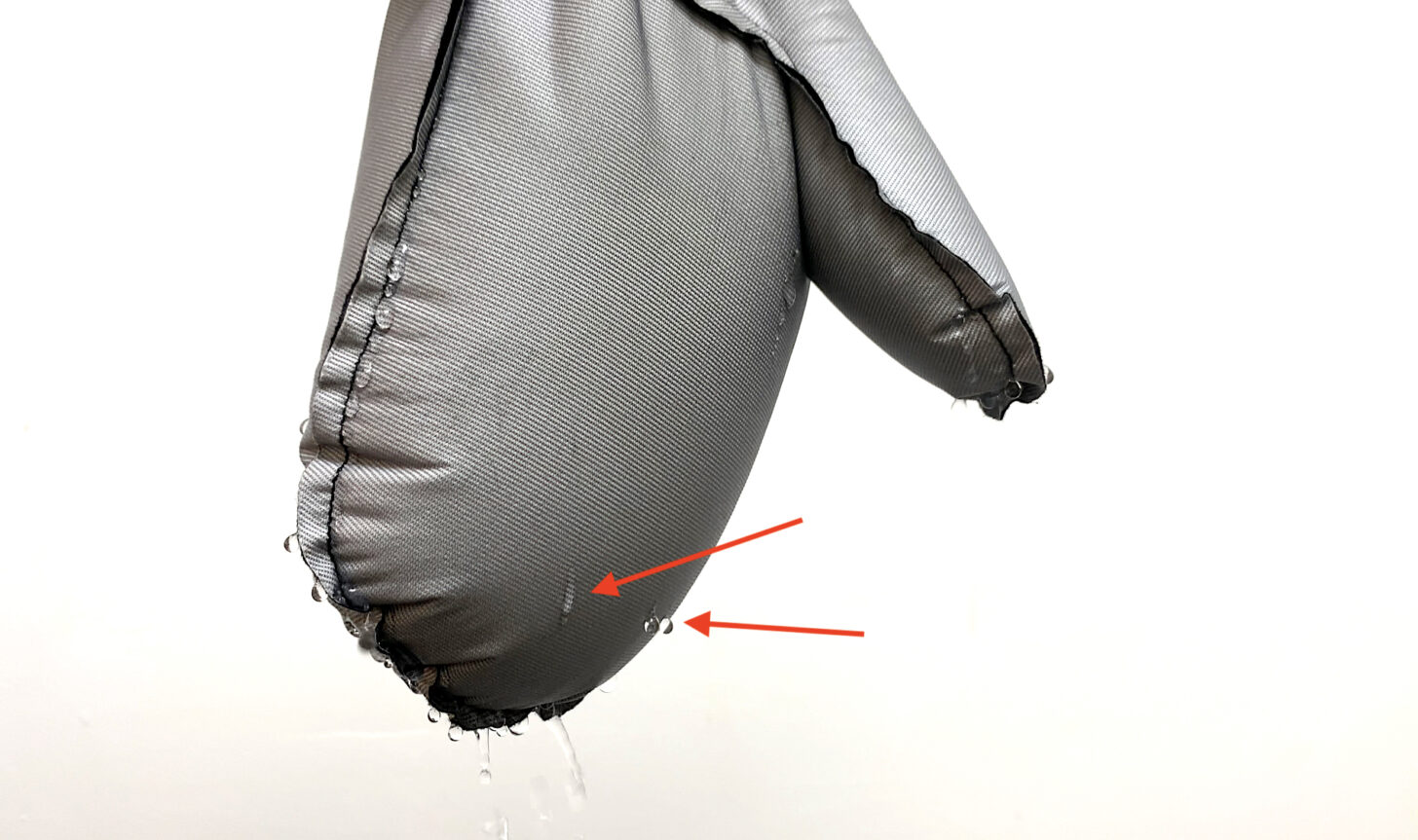Introduction
Ultralight backpackers are sometimes accused of having to suffer in inclement conditions because they don’t bring enough gear to stay comfortable. Rain mitts are often one of the first items to get dropped from our gear list – not necessarily because they are heavy, but because it’s another item to keep track of, and we enjoy the simplicity of a minimalist kit with as few items as possible.
However, when temperatures drop and we find ourselves trekking in cold rain or snow, our hand comfort is sometimes the first to go. The discomfort is magnified when we try to use our trekking poles or ice axe, the precipitation continues for several hours, or as we hike into the falling temperatures of the evening hours. Often, we stow the poles or axe and stuff our hands in our pockets, wishing we had brought along that 2-ounce pair of rain mitts.

In addition, in very cold, wet, or windy conditions, rain mitts provide an important buffer against cold hands, allowing us to Do Stuff. We still need to tie our shoes, operate zippers, access snacks from a ziploc baggie, use our stove, apply first aid, and setup our tent. Warm hands are essential for performing these fine motor skill-based activities.
But not all rain mitts are created equal.
Some are heavy (they generally weigh more than 3 ounces / 85 g) and bulky. They are built for durability for mountaineering, skiing, and snowboarding, rather than backpacking. Heavier fabrics and larger sizing prevent these types of shell mittens from layering well over the thinly-insulated handwear (e.g., liner gloves) used by backpackers in 3-season conditions. An example of a shell mitten from this category is the Black Diamond Waterproof Overmitts (3.7 ounces / 105 g per pair). A backpacker might consider a shell mitten like this for winter ski- or snowshoe-backpacking, but they are overkill for 3-season conditions.
While we do include some shell mitts that are intended for snow sports use in this gear guide, the focus will be on the use of shell mitts for backpacking in cold, wet, or windy conditions.
Browse our curated recommendations for rain mitts and other handwear in the Backpacking Light Gear Shop – a product research & discovery tool where you can find Member gear reviews, Gear Swap (used gear) listings, and more.
Alternatives to Rain Mitts
Rain mitts aren’t necessarily an essential item for routine summer backpacking when temperatures are generally warm and precipitation is infrequent. However, rain mitts can provide some valuable insurance in cold, wet conditions that keep your hands warm so you can keep hiking comfortably, or use your gear safely and effectively (operating a stove, setting up a shelter, etc.).
Gram-counting ultralight backpackers who eschew the unnecessary (or those among the rest of us who intentionally left our rain mitts behind but accidentally find ourselves facing a situation where we miss them) may use a variety of strategies in lieu of rain mitts in a pinch:
- Nothing (bare hands) – Oops, we forgot our gloves as well, so our hands get stuffed in our pants or jacket pockets, or inside the cuffs of our rain jackets (we hope the jacket sleeves are long enough).
- Thin gloves/liners – In cold rain, saturated liner gloves provide minimal protection when we’ve found ourselves in this situation. When it’s windy and the temperatures are in the 30 °F (-1 °C) range, the soggy gloves get stuffed in the pack and numb hands go in pockets.
- Weather-resistant gloves or mittens – So-called weather-resistant gloves or mittens are made from fabrics that provide some barrier to wind and water, but it’s only a matter of time before they wet out. They are heavier than liners, and buy you some time, but still not a great option for sustained wet conditions. Powerstretch and Windstopper are examples of materials that tout weather resistance but absorb a lot of water and are slow to dry.
- Plastic bags, stuff sacks, or waterproof oversocks – worn over liners in a pinch, not a bad option for intermittent cold rain showers.
- Waterproof gloves – Some prefer a waterproof (non- or poorly-breathable) glove worn over a liner. Examples include latex gloves worn over liners, dishwashing gloves, neoprene, or nitrile-coated work gloves.

Rain Mitt Gear Guide: Scope and Context
Category Description
A rain mitt is like a rain jacket for your hands. The category of ultralight rain mitts is defined by uninsulated mitten shells made of waterproof fabric that can either be worn alone or layered over insulating gloves or mittens to help keep hands warm and dry while hiking and camping in cold, wet, or windy conditions.
Rain Mitts: Strengths and Limitations
The primary limitation of any mitten system is articulation. When wearing a mitten, five fingers are housed in two compartments, making it difficult to perform fine-motor tasks like operating a stove, using your phone or camera, zipping a small zipper, or tying your shoe. Doing these things while wearing mitten shells requires practice and intentional focus – especially when your mental energy is already being diverted towards coping with cold and wet conditions.
Others have criticized conventional rain mitt systems based on the idea that waterproof-breathable fabrics are compromised when subjected to abrasion (which impacts waterproofing) and body oils (which impacts breathability). For the vast majority of backpackers and thru-hikers, however, these are strawman arguments. Body oils in waterproof-breathable fabrics are easily washed out with regular laundering. And abrasion while performing routine actions like using trekking poles or setting up a tent is minimal.

Most backpackers will find that a rain mitt worn over a liner or insulating glove or mitten is warmer and more comfortable for hiking in an all-day rain than any glove system. And, those hikers who don’t need the durability associated with heavy fabrics can enjoy the benefits of some very light rain mitts that are entirely appropriate for just-in-case scenarios.
I (Ryan) had the privilege of hiking a long, Wyoming high route with my friend and colleague Don Ladigin in the early 2000s. One of the lasting lessons I learned from Don was using simple fleece mittens and simple waterproof overmitts for keeping your hands as warm as possible for as little weight as possible. He was wise beyond his years, and I never forgot the lesson. Also, I’ve never found anything better than a simple fleece glove/mitten + shell/rain mitt combo for backpacking.
Among the 3-season shell mitten (i.e., rain mitt) category, some of the shortcomings of existing products include:
- sloppy fit, poor articulation
- wrist closures and hem cuffs don’t stay in place (often due to using materials that are too light)
- not waterproof enough: seams require the user to seal them at home (a messy and inconsistent method of waterproofing sewn seams), or fabrics that are poorly water-resistant
- too slippery: palms aren’t grippy enough for securely handling trekking poles or hiking axes
- too difficult to use: closures can’t be easily adjusted with one hand
Rain Mitt Design: Attributes and Features
When considering the functionality of a rain mitt, pay attention to the following attributes:
- Body Fabric. The main body fabric of a rain mitt is generally a 2- or 3-layer waterproof-breathable, ripstop-nylon sandwich. Fabric weights range from 1 to 4 oz/yd2. Lighter fabrics result in better articulation and fine motor use. Heavier fabrics are warmer, more water-resistant, and more durable. Some mitts use a stretch fabric, which provides a little give when gripping trekking poles and layering the mitt over a thicker glove (i.e., when space gets a little tight inside the mitt).
- Seam Taping. Some mitts offer taped seams, others do not. Without seam taping, a mitt can’t be considered waterproof. While some manufacturers (notably, cottage brands) advise seam sealing their untaped mitts, sealing is imprecise and prone to failure. Plus, we hikers are lazy, and often skip this step. That gives us the license to complain later on when our mitts leak and helps justify our two-star reviews of unsealed/untaped rainwear.
- Palm Fabric. Palms may be reinforced with thermally-fused patches of grippier material or made with an additional layer of grippy fabric (usually textured polyurethane, referred to hereafter as TPU). Palm grips add weight and compromise articulation. However, they also add water resistance, warmth, and durability, and improve the handling of tools like trekking poles and ice axes.
- Gauntlet Length. A longer gauntlet adds weight but improves the seal between the rain jacket cuff and the rain mitt cuff by creating more overlap. This is particularly useful if you are scrambling or reaching while wearing the mitts. Longer gauntlets generally add a little warmth and water resistance to your layering system.
- Patterning/Thumb Articulation. Articulated patterns that match the natural, relaxed curvature of the hand and thumb are more comfortable and provide better motor control, especially for rain mitts made with heavier fabrics. Less sophisticated patterning is generally found among cottage industry rain mitts. And, to be honest, it’s not that necessary with ultralight fabrics. Aesthetic patterning is nice, but not essential with ultralight fabrics that don’t provide much resistance to digit motor movement. Using articulation as a benefit in product marketing is reaching a bit, you guys.
- Gauntlet Hem/Closure. An elastic-bound gauntlet hem is generally less durable than a drawcord hem, due to the fragile and abrasion-prone nature of elastic binding. An adjustable drawcord closure (ideally, with a single-hand use toggle) keeps the rain mitt secure in the worst weather.
- Wrist Adjustment. Some rain mitts offer a strap (adjusted and secured by a hook-and-loop patch or ladderloc buckle) or adjustable drawcord and toggle at the wrist to secure the rain mitt in place. Rain mitts with both gauntlet hem closures and a wrist adjustment mechanism will be the most secure and add to the mitt’s comfort by keeping the fingers where they’re supposed to be in the mitt, rather than slopping around.

What products are included in this Rain Mitt Gear Guide, and why?
For this gear guide, we included 16 models of rain mitts weighing less than 4 ounces (113 g) per pair.
Not included in this gear guide are waterproof shell gloves which are (generally) less common, less warm, more prone to failure, more expensive, and more limited in terms of layering options.
DISCLOSURE (Updated April 9, 2024)
- Product mentions in this article are made by the author with no compensation in return. In addition, Backpacking Light does not accept compensation or donated/discounted products in exchange for product mentions or placements in editorial coverage.
- Some (but not all) of the links in this review may be affiliate links. If you click on one of these links and visit one of our affiliate partners (usually a retailer site), and subsequently place an order with that retailer, we receive a commission on your entire order, which varies between 3% and 15% of the purchase price. Affiliate commissions represent less than 15% of Backpacking Light's gross revenue. More than 70% of our revenue comes from Membership Fees. So if you'd really like to support our work, don't buy gear you don't need - support our consumer advocacy work and become a Member instead.
- Learn more about affiliate commissions, influencer marketing, and our consumer advocacy work by reading our article Stop wasting money on gear.
Table: Rain Mitts for Backpacking (Features and Specifications Comparison)
| experience | size tested | weight (pair) | MSRP | fabric | seam-taped | gauntlet length | cuff closure | wrist adjustment | palm reinforcement | |
|---|---|---|---|---|---|---|---|---|---|---|
| REI Minimalist GTX Mittens | extensive | M | 1.7 oz (49 g) | discontinued | 3L Goretex | yes | short | elastic | hook-and-loop | none |
| REI Minimalist GTX Mittens 2.0 | moderate | M | 1.6 oz (47 g) | $50 | 3L Goretex stretch | yes | short | elastic | hook-and-loop | yes, TPU grip patches only |
| Outdoor Research Revel Shell Mitt | extensive | S | 3.1 oz (88 g) | $69 | 2.5L Pertex Shield | yes | long | drawcord, adjustable, single-hand toggle, also includes removable security leashes (0.2 oz / 6 g) | webbing, ladderloc buckle | yes, full, TPU |
| Outdoor Research Helium Shell Mitts | moderate | M | 0.8 oz (23 g) | $50 | 2.5L Pertex Shield | yes | short | elastic | none | none |
| Black Diamond Waterproof Overmitts | extensive | M | 3.3 oz (94 g) | $90 | 3L wp/b stretch | yes | long | drawcord, adjustable, single-hand toggle | elastic | yes, TPU grip patches only |
| ZPacks Vertice Rain Mitts | extensive | M | 0.8 oz (23 g) | $69 | 3L wp/b 7d | yes | long | drawcord | none | none |
| Mountain Laurel Designs eVENT Rain Mitts | extensive | M | 1.2 oz (35 g) | $45 | 3L eVENT | no | long | drawcord, adjustable, single-hand toggle | none | none |
| Enlightened Equipment Visp Rain Mitts | extensive | M | 0.7 oz (19 g) | $30 | 3L ePTFE 7d | no | long | drawcord, adjustable, single-hand toggle | drawcord, adjustable, single-hand toggle | none |
| RaidLight MP+ Waterproof Overmitt | extensive | M | 0.8 oz (23 g) | 45€ | 2L Nylon/PU | yes | short | elastic | hook-and-loop | none |
| Borah Gear eVENT Rain Mitts | extensive | M | 1.0 oz (28 g) | $30 | 3L eVENT | no | long | drawcord, adjustable | none | no grip, but slightly heavier fabric |
| OMM Kamleika Overmitt | minimal | M | 1.1 oz (30 g) | £35 | 2L wp/b stretch PU | yes | short | elastic | elastic | none |
| Inov8 All-Terrain Pro Mitt | moderate | 0.8 oz (23 g) | $30 | 3L wp/b | yes, welded | short | stretch elastic, wide | none | none | |
| YAMA Mountain Gear Rain Pogies | extensive | S/M | 0.9 oz (26 g) | $18 | 30d silnylon | no | short | drawcord, adjustable | n/a | none |
| Montane Endurance Pro Waterproof Mitt | moderate | M | 2.2 oz (62 g) | $115 | 70d 3L Goretex Pro | yes | long | drawcord, adjustable, single-hand toggle | elastic | yes, full, TPU |
| Forclaz Trek 500 Overgloves | moderate | M | 1.3 oz (37 g) | $17 | 2L wp/b | yes | short | elastic | webbing, ladderloc buckle | yes, TPU patches |
| Terra Nova Extremeties Tuff Bags GTX | extensive | M | 2.6 oz (75 g) | £60 | 2.5L Goretex Paclite | yes | long | drawcord, adjustable, single-hand toggle | webbing, ladderloc buckle | yes, full, TPU |
Table Notes:
- Experience indicates the extent of testing we performed with each model of rain mitt over the course of the past year. Moderate experience = 7 to 14 days of worn use; Extensive experience = 30+ days of worn use.
- The gauntlet length is measured as the distance from the user’s wrist (base of thumb) to the rain mitt cuff when the hand is inserted as far as possible into the mitt. A short gauntlet is one that does not reach more than about an inch beyond the wrist bones. A long gauntlet is one that reaches at least two inches beyond the wrist bones.
- All weights are actual measured weights by the authors of the size indicated.
Performance
Testing Protocols
For this gear guide, most of the rain mitts were subjected to six months to two years of use over the course of four seasons. Mitts were evaluated as follows:
- Waterproofing – rain mitts were exposed to heavy cold external water pressure (a showerhead) while wearing absorbent gloves underneath them, followed by submersion of the mitt-clad hand in cold water (up to but not including the cuff). In addition, we turned the mitts inside out and filled them with water, and then recorded video footage of them, so we could observe any fabric or seam leaks in real-time.
- Breathability – rain mitts were used during high exertion activity (trail running or hiking uphill with a heavy pack) while wearing a fleece glove underneath and subjectively evaluated them for clamminess.
- Articulation and Fit – rain mitts were evaluated for their comfort while using trekking poles, operating a headlamp, opening/closing a jacket zipper, opening/closing a zip-closure plastic baggie, operating an upright canister stove, using a Garmin inReach Mini, and setting up a tent.
- Sizing – rain mitt sizing was evaluated by the relative comfort/constriction when layered over a midweight fleece glove (Columbia Fast Trek Fleece).
- Durability – rain mitts were subjected to long-term use and all were used with trekking poles, for firewood collection, during talus scrambling, and while bushwhacking.

Testing Conditions
All rain mitts were subjected to four-season use primarily in the Rocky Mountains of Wyoming and Northern Colorado. Other areas where we tested them included Southern Appalachia, the Olympic and Cascade ranges of the Pacific Northwest, the Sierra High Route, the Bob Marshall and Absaroka-Beartooth Wilderness areas in Montana, and the Sawtooth Range in Idaho. Specific use cases included the following:
- 3-season backpacking in intermittently rainy conditions.
- 3-season backpacking in sustained rainy or heavy, wet snow conditions.
- Winter backpacking in cold, windy conditions.
- Winter backpacking in cold, snowy (blizzard) conditions.
- Off-trail backpacking involving bushwhacking and/or talus scrambling requiring the use of shell mitt-clad hands.

Member Exclusive
A Premium or Unlimited Membership* is required to view the rest of this article.
* A Basic Membership is required to view Member Q&A events




Home › Forums › Ultralight Rain Mitts for Backpacking: Reviews & Gear Guide